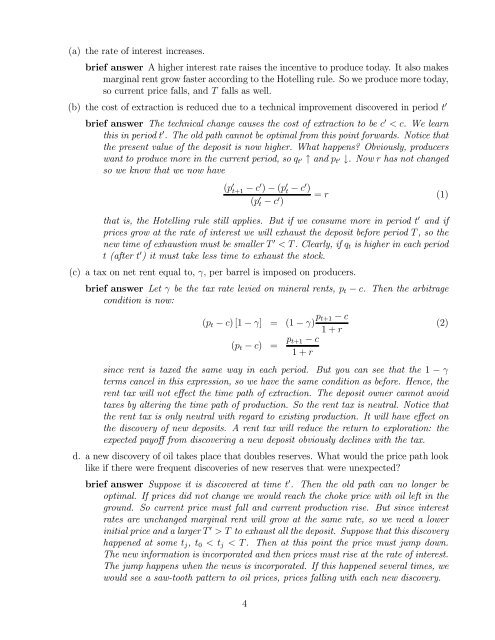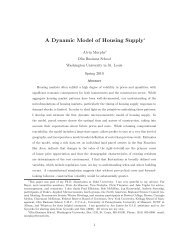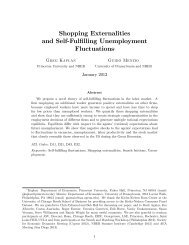Midterm Exam 1: Answer Sheet
Midterm Exam 1: Answer Sheet
Midterm Exam 1: Answer Sheet
- No tags were found...
You also want an ePaper? Increase the reach of your titles
YUMPU automatically turns print PDFs into web optimized ePapers that Google loves.
(a) the rate of interest increases.brief answer A higher interest rate raises the incentive to produce today. It also makesmarginal rent grow faster according to the Hotelling rule. So we produce more today,so current price falls, and fallsaswell.(b) the cost of extraction is reduced due to a technical improvement discovered in period 0brief answer The technical change causes the cost of extraction to be 0 .Welearnthis in period 0 . The old path cannot be optimal from this point forwards. Notice thatthe present value of the deposit is now higher. What happens? Obviously, producerswant to produce more in the current period, so 0 ↑ and 0 ↓. Now has not changedso we know that we now have( 0 +1 − 0 ) − ( 0 − 0 )( 0 − 0 )= (1)that is, the Hotelling rule still applies. But if we consume more in period 0 and ifprices grow at the rate of interest we will exhaust the deposit before period ,sothenew time of exhaustion must be smaller 0 . Clearly, if is higher in each period (after 0 ) it must take less time to exhaust the stock.(c) a tax on net rent equal to, per barrel is imposed on producers.brief answer Let be the tax rate levied on mineral rents, − . Then the arbitragecondition is now:( − )[1− ] = (1− ) +1 − (2)1+( − ) = +1 − 1+since rent is taxed the same way in each period. But you can see that the 1 − terms cancel in this expression, so we have the same condition as before. Hence, therent tax will not effect the time path of extraction. The deposit owner cannot avoidtaxes by altering the time path of production. So the rent tax is neutral. Notice thatthe rent tax is only neutral with regard to existing production. It will have effect onthe discovery of new deposits. A rent tax will reduce the return to exploration: theexpected payoff from discovering a new deposit obviously declines with the tax.d. a new discovery of oil takes place that doubles reserves. What would the price path looklike if there were frequent discoveries of new reserves that were unexpected?brief answer Suppose it is discovered at time 0 . Then the old path can no longer beoptimal. If prices did not change we would reach the choke price with oil left in theground. So current price must fall and current production rise. But since interestrates are unchanged marginal rent will grow at the same rate, so we need a lowerinitial price and a larger 0 to exhaust all the deposit. Suppose that this discoveryhappened at some , 0 . Then at this point the price must jump down.The new information is incorporated and then prices must rise at the rate of interest.The jump happens when the news is incorporated. If this happened several times, wewould see a saw-tooth pattern to oil prices, prices falling with each new discovery.4
















